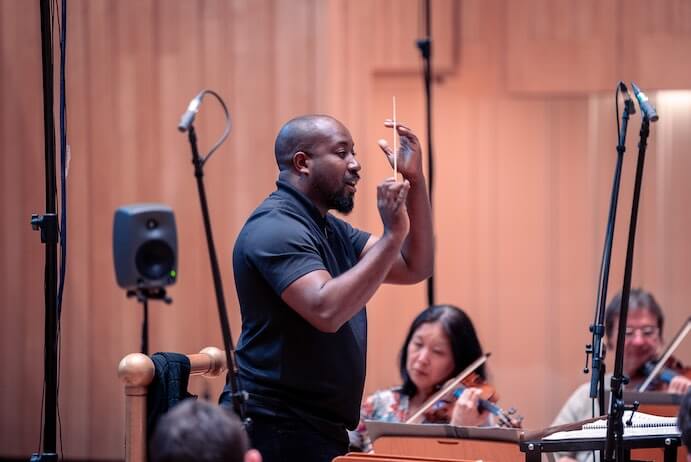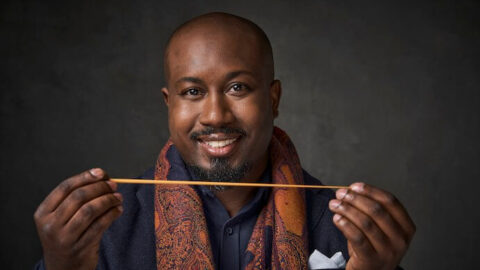Renowned conductor Kellen Gray has gained recognition for championing the works of Black composers. A native of South Carolina, Gray weaves the influences of Black folk tradition from his upbringing in the American South with his dedication to telling Black stories from the podium. He currently serves as assistant conductor of the English National Opera and has held appointments with the Royal Scottish National Orchestra and the Chicago Sinfonietta.
Gray’s debut album, African American Voices, highlights his resolve by programming Black American composers William Grant Still, William Levi Dawson, and George Walker, all widely regarded for recounting African-American idioms in their scores.
On African American Voices II, out Oct. 13 on Linn Records, Gray leads the RSNO in exploring the vastness of the African-American voice in classical music. The album also marks the first commercially available recordings of works by Margaret Bonds, Ulysses Kay, and Coleridge-Taylor Perkinson. Bonds’ Montgomery Variations invites a rare look into the composer’s approach to orchestral writing. Inspired by the first decade of the Civil Rights movement, the seven-movement work is a theme and variations on the African-American spiritual I Want Jesus to Walk with Me.
From the bright and declarative opening to the somber yearning of the later movements, Gray transports us to a place of meditation and reflection. The album is bookended by Perkinson’s nod to the music of the Black church with a rhythmically and harmonically dense rendition of “Praise God From Whom All Blessings Flow.” Creating a transition between the two works is Kay’s Concerto for Orchestra, which showcases the brilliance of the RSNO in this recording through alluring solos and robust tutti pageantry.
Can you tell us what it was like preparing a largely Scottish orchestra to play music that is unique to the Black American experience?
At the Royal Scottish National Orchestra (RSNO), we’re fortunate to have players from all around the globe: many from Scotland, and others from parts of the U.K., Spain, Poland, France, Brazil, Denmark, the USA, and beyond.
Though the music we prepared for these two albums is mostly based on early African-American folk idioms, the RSNO musicians have an understanding of and pride for the folk music from their own homelands, and often the musical concepts are similar. The most significant hurdle is changing the lens through which we filter the notes and rhythms — knowing when to apply our classical music treatment, and when to use our folk music treatment.
It’s been a special adventure for me to introduce the RSNO to the spirituals, hymns, jubas, and early pre-jazz forms of my home and the music that surrounded me in my early life. In the rehearsal process, I’d sing the original source material to the orchestra and clap and stomp the syncopated Gullah rhythms that give them the authentic style. The musicians have a true hunger for striving to extract the same emotion from the orchestrated material as elicited by the folk music’s original setting.
We’ve really grown a great trust in each other through these projects. The RSNO is likely the only orchestra in the world doing a multiple-year exploration of the performance practice of African-American composers who use folk music idioms as the foundation of their work. It’s a testament to commitment of the players, but also to the organization as a whole in so actively embracing and championing such a project.

With two installments of African American Voices now recorded, what is something you hope listeners will take away from part two that may be different from part one?
The first installment of African American Voices focused on the first two published symphonies by African-American composers: William Dawson’s Negro Folk Symphony and William Grant Still’s Symphony No. 1 “Afro-American.” Neither were previously recorded by the tandem of a major orchestra and a conductor who is of the culture, born in the folk music traditions from which the symphonies were woven.
From the second installment, African American Voices II, I hope it becomes obvious to our listeners that there is a diverse array of musical voices among African-American composers. Because of the limited scope in which composers of African descent have been historically presented, it can be easy for someone to assume there is a sameness or a central aesthetic among them. One could think they all came from the same time period and only a few regions. In reality, works by composers of African descent trace back the mid-1500s and lived on nearly every continent of the earth. It was only in the 20th century that at least some of the societal barriers that suppress their work subsided — and I do emphasize SOME, not all.
A great example would be Joseph Bologne, also known as the Chevalier de Saint-Georges (1745-1799). While alive, he was France’s most well-known composer, principal conductor of the Paris Opera, the first French military officer of African descent, and a world-renowned fencing champion. He was wildly famous; literally streets named after him! We are only now rediscovering his work because, upon Bologne’s death, Napoleon had any trace of the composer’s existence destroyed so that his memory could not be used as an inspiration for any of the African slaves of the French colonies.
Each of the three composers on African American Voices II are distinctly different, presenting their own unique musical language and influences from the time in which they lived: Margaret Bonds’ use of spirituals to write a work inspired by the events of the U.S. Civil Rights movement, Ulysses Kay’s manner of using early music forms like toccatas and passacaglias to set mid-century American language similar to Copland while also employing African-American songs or dance idioms, and Coleridge Taylor-Perkinson, who was equal parts jazz musician and classical composer, finding a way to organically combined both in his overture, Worship.
If programming is the first and/or only place we’re addressing diversity, then we’re overlooking many essential elements.
Your biography highlights your orchestral conducting experience, including appointments with the English National Opera and the Charleston Symphony Orchestra. What are some of the differences and challenges of conducting in Europe vs. in the U.S.?
Today, any musician in a professional orchestra is highly trained, adaptable, and able to play anything. I think where you find differences is in the institutional culture around what an orchestra, as a whole, performs most often. This can come from a variety of reasons, everything from what their audiences enjoy most to the specific expertise of their music director.
Living in the U.K. primarily for the last three years, I’ve performed more Britten, Elgar, and Vaughn Williams than I’ve heard in the entirety of my life living in the U.S. The reverse can be said regarding Copland, Bernstein, and Gershwin. With the stylistic differences between the most frequently played works, small differences like the general approach and application of articulation may vary. What I find most interesting is gaining an understanding of an orchestra’s style through our initial moments together, finding language that connects us to the sound, and how to best achieve that sound.
As conductors and classical music organizations look to diversify their programming, what is one factor you believe is often overlooked?
Short answer… if programming is the first and/or only place we’re addressing diversity, then we’re overlooking many essential elements.
Diversifying programming is certainly a positive, but its benefits are marginal and only performative if we’re not also addressing diversity, inclusion, and belonging on the stage, and in the organization’s offices, board, audience, and partnerships. Lasting change comes when we’re willing to face the issues that are central to the very reasons we need to address diversity.
Most often, our audiences resemble the make-up of our boards, and the relationships we build are reflective of what an organization values most — fundraising boards are born from a focus on finance, and working boards support organizations that need the bandwidth. Boards that are diverse and focused on a culture that is inclusive and creates a sense of belonging help alter an organization’s DNA by removing many of the exclusionary barriers set in place from the start of our industry.
That being a starting point, a common missed opportunity is not tapping into resources that can deepen an artistic staff’s frame of reference for composers that aren’t male and/or European. Beyond the simple world-wide-web search, resources such as the African Diaspora Music Project, a database of African-descended composers, and Latin Orchestral Music, a catalog of Latin American and Caribbean composers and works, or Donne: Women in Music, a foundation and database championing the inclusion of women in classical music, are incredible resources to begin a journey and sustain a learning effort continually.
[Tweet “Diversifying programming is certainly a positive, but its benefits are marginal and only performative if we’re not also addressing diversity, inclusion, and belonging on the stage, and in the organization’s offices, board, audience, and partnerships.”]
After the release of two successful albums, what’s next for you?
It’s very early in my 2023-2024 season. I’m looking forward to reuniting with the RSNO for performances in Glasgow and Edinburgh later this year, assisting La Traviata at the English National Opera, and conducting other programs in the U.K. and USA with the Philharmonia Orchestra, Louisiana Philharmonic, Baltimore Symphony Orchestra, National Symphony Orchestra (USA), Ann Arbor Symphony, Lafayette Symphony, and others.
When I’m not performing I’ll continue my research of great works by composers of African descent and early African American folk music performance practice in hopes of future concerts and recording projects. There are so many more African American composers to celebrate!
I CARE IF YOU LISTEN is an editorially-independent program of the American Composers Forum, and is made possible thanks to generous donor and institutional support. Opinions expressed are solely those of the author and may not represent the views of ICIYL or ACF.
You can support the work of ICIYL with a tax-deductible gift to ACF. For more on ACF, visit the “At ACF” section or composersforum.org.
























